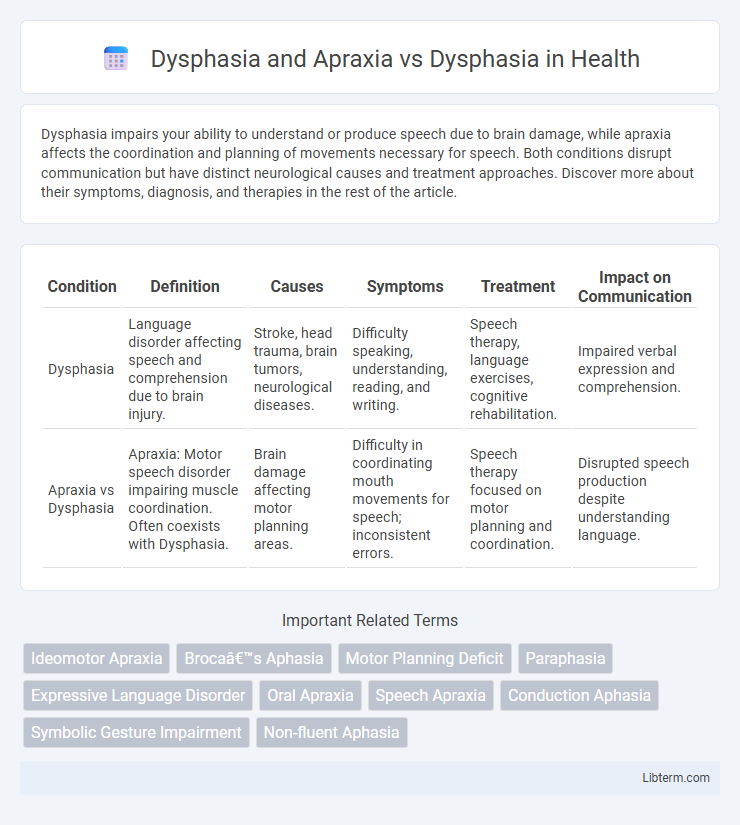Dysphasia impairs your ability to understand or produce speech due to brain damage, while apraxia affects the coordination and planning of movements necessary for speech. Both conditions disrupt communication but have distinct neurological causes and treatment approaches. Discover more about their symptoms, diagnosis, and therapies in the rest of the article.
Table of Comparison
| Condition | Definition | Causes | Symptoms | Treatment | Impact on Communication |
|---|---|---|---|---|---|
| Dysphasia | Language disorder affecting speech and comprehension due to brain injury. | Stroke, head trauma, brain tumors, neurological diseases. | Difficulty speaking, understanding, reading, and writing. | Speech therapy, language exercises, cognitive rehabilitation. | Impaired verbal expression and comprehension. |
| Apraxia vs Dysphasia | Apraxia: Motor speech disorder impairing muscle coordination. Often coexists with Dysphasia. | Brain damage affecting motor planning areas. | Difficulty in coordinating mouth movements for speech; inconsistent errors. | Speech therapy focused on motor planning and coordination. | Disrupted speech production despite understanding language. |
Understanding Dysphasia: Definition and Symptoms
Dysphasia is a language disorder caused by brain damage that impairs speech production and comprehension, while apraxia affects motor planning, disrupting the ability to perform coordinated speech movements. Symptoms of dysphasia include difficulty finding words, forming sentences, and understanding spoken or written language. In contrast, apraxia's hallmark is inconsistent speech errors despite intact muscle function, highlighting the distinction between language processing and motor coordination impairments.
What is Apraxia? Key Features and Presentation
Apraxia is a motor speech disorder characterized by difficulty in planning and coordinating the movements required for speech, despite having the physical ability to speak. Key features include inconsistent speech errors, groping for correct sounds, and difficulty imitating speech or performing voluntary movements upon request, distinguishing it from dysphasia, which primarily involves language processing deficits. Apraxia typically presents with disrupted articulation and prosody, while comprehension and linguistic knowledge remain relatively intact.
Dysphasia and Apraxia: How They Interact
Dysphasia and apraxia interact significantly, as dysphasia impairs language comprehension and expression, while apraxia affects the motor planning needed for speech production. Co-occurrence of both conditions can exacerbate communication difficulties, requiring integrated therapeutic approaches targeting both linguistic deficits and motor speech coordination. Understanding the neurological overlap in brain regions responsible for language and motor control is crucial for effective rehabilitation strategies.
Dysphasia vs. Dysphasia with Co-Occurring Apraxia
Dysphasia, a language processing disorder, impairs the ability to understand or produce speech, while co-occurring apraxia complicates this by disrupting the motor planning required for speech articulation. Patients with both dysphasia and apraxia often experience more severe communication difficulties due to the combined cognitive-linguistic and motor speech impairments. Effective diagnosis and tailored therapy must address both language comprehension and motor execution deficits to improve functional communication outcomes.
Causes and Risk Factors: Dysphasia Alone vs. Combined Disorders
Dysphasia primarily results from brain damage affecting language centers, often due to stroke, traumatic brain injury, or neurodegenerative diseases, with risk factors including hypertension, diabetes, and advanced age. When dysphasia occurs alongside apraxia, the combined disorder indicates more extensive cortical or subcortical damage typically involving the motor planning areas, amplifying the complexity of speech and language impairments. The presence of both dysphasia and apraxia often correlates with larger lesions or more severe neurological events, increasing the risk profile compared to dysphasia alone.
Diagnostic Differences Between Dysphasia and Apraxia
Diagnostic differences between dysphasia and apraxia primarily revolve around language comprehension and motor planning. Dysphasia involves impaired understanding and formulation of language due to neurological damage, often identified through speech-language assessments focusing on syntax, semantics, and fluency. In contrast, apraxia is characterized by difficulty in motor planning for speech production without linguistic deficits, diagnosed via tests evaluating the coordination and execution of voluntary speech movements.
Common Assessment Tools for Dysphasia and Apraxia
Common assessment tools for dysphasia and apraxia include standardized tests such as the Western Aphasia Battery (WAB) and the Boston Diagnostic Aphasia Examination (BDAE) for dysphasia, which evaluate language comprehension, expression, and fluency. For apraxia, tools like the Apraxia Battery for Adults (ABA-2) specifically assess motor planning and execution of speech movements. Speech-language pathologists often utilize observational assessments and task-specific evaluations to differentiate the presence and severity of both dysphasia and apraxia during clinical diagnosis.
Speech Therapy Approaches: Solo Dysphasia vs. Dysphasia with Apraxia
Speech therapy for solo dysphasia primarily targets language comprehension and expression through strategies like semantic feature analysis and structured language drills. When dysphasia co-occurs with apraxia, therapy emphasizes motor planning and coordination exercises, integrating techniques such as repetitive practice, multisensory cueing, and articulatory kinematic approaches. Tailoring interventions to address both linguistic deficits and motor speech impairments enhances communication outcomes more effectively than one-dimensional treatment plans.
Prognosis: Recovery Outcomes in Each Condition
Dysphasia and apraxia each present distinct recovery outcomes influenced by the underlying neurological damage and therapy intensity. Dysphasia often shows significant improvement with early, targeted speech-language interventions, especially in ischemic stroke cases affecting language centers like Broca's or Wernicke's area. Apraxia, characterized by motor planning deficits, may require prolonged rehabilitative efforts focused on motor programming, resulting in variable prognosis dependent on lesion location and severity.
Supporting Individuals: Practical Tips for Families and Caregivers
Supporting individuals with dysphasia and apraxia requires tailored communication strategies that enhance understanding and expression, such as using simple sentences, visual aids, and allowing extra response time. Families and caregivers benefit from speech therapy collaboration and consistency in daily routines to reinforce language skills and motor planning. Encouraging patience and creating a low-stress environment significantly improves engagement and progress in communication abilities.
Dysphasia and Apraxia Infographic

 libterm.com
libterm.com